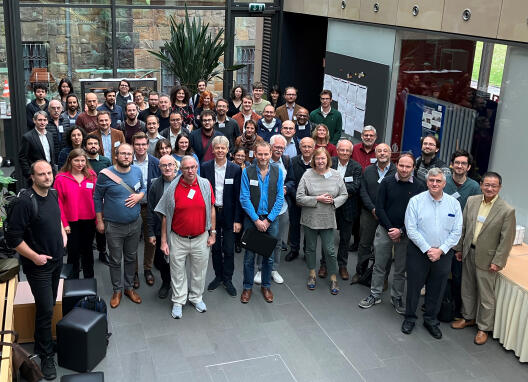798. WE-Heraeus-Seminar at Physikzentrum Bad Honnef

The strong interaction and its theoretical description in the context of quantum chromodynamics (QCD) play an important role at the Large Hadron Collider (LHC) at CERN in Geneva and at the Electron Ion Collider (EIC) currently under construction at Brookhaven National Laboratory in New York. Forward-scattered protons and nuclei are of particular interest because they allow high-resolution structural studies of these strongly bound states of quarks and gluons, even in three dimensions at the EIC. These are made possible by special detectors, which ATLAS and CMS already have and which are planned for ALICE and the EIC, and the special geometry of the LHCb experiment.
The Heraeus seminar and LHC working group meeting on this topic, which took place at the Physikzentrum in Bad Honnef from October 23-27, 2023, was attended by 32 of the world's leading experts from Europe and the USA and almost as many younger researchers. The enormous progress made in the past ten years, not only on proton structure but also on nuclear structure, became clear at this conference. The questions of how clear signals of the theoretically expected gluon saturation can be obtained or how so-called odderon states can be proven beyond doubt were discussed intensively. The discovery of light-to-light scattering was also spectacular. It is now being used to search for dark matter and new interactions.
Discussions on the future experimental program in the high-luminosity phase of the LHC, with the Forward Physics Facility at CERN and special detectors at the EIC as well as in cosmic rays took up a lot of space. Possible discoveries could then be new exotic hadrons, the anomalous magnetic moment of the tau lepton or axions, assuming adapted beam optics and increased sensitivity and durability of the detectors.
With its intensive and varied scientific program, invited longer and other shorter lectures, posters and discussions, the seminar was a great success and aroused the desire for continuation and even more intensive collaboration. Three of the outstanding contributions from the younger participants were awarded poster prizes. Our heartfelt thanks go to the Wilhelm and Else Heraeus Foundation for their generous financial and professional organizational support and to the team at the Physikzentrum for their excellent support during the seminar.
The seminar was organized by Prof. Paul Newman, University of Birmingham, Prof. Christophe Royon, University of Kansas and Humboldt research award winner with University of Münster, and Prof. Michael Klasen, University of Münster.

